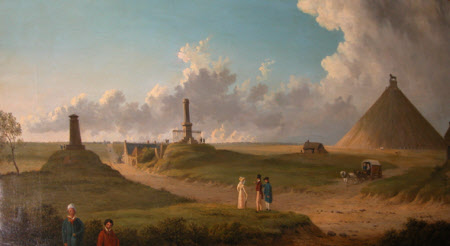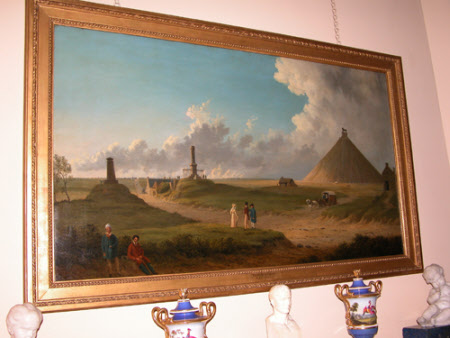The Field of Waterloo
James Arthur O'Connor (Dublin 1791 - London 1841)
Category
Art / Oil paintings
Date
1826 - 1841
Materials
Oil on canvas
Measurements
615 x 1103 mm
Place of origin
England
Order this imageCollection
Anglesey Abbey, Cambridgeshire
NT 515545
Summary
Oil painting on canvas, The Field of Waterloo by James Arthur O'Connor (Dublin 1791 - London 1841). The Field of Waterloo is seen with the Hanoverian, Gordon and Lion monuments on either side of the road on the left. Groups of figures inspect the monuments, and a covered wagon with two horses are on the right. The Hanoverian monument (on left) was erected in 1818 to commemorate soldiers of King’s German Legion who defended Haie-Sainte farm which can be seen a little further down road to right. The Hanoverian Dead numbered some 4,000. Monument was restored in 1914 & 1940. Names of thirty-nine Hanoverian officers inscribed on stone. Architect not known. The Gordon monument (in centre) was erected in 1817 by the Aberdeen family. Dedicated to Sir Alexander Gordon, aide-de-camp to Duke of Wellington, who was mortally wounded at Waterloo. The Lion mound (on right) was erected by the Dutch between 1823-1826 on the spot where Prince of Orange was wounded. He commanded a corps in the allied army. Architect was Van der Straeten whose project was chosen after open contest. It consists of circular mound, surmounted by sculpted lion, created from soil and debris of battlefield upon which 45,000 men and countless horses had been killed within two days. There are 183 steps to the top of the monument.
Provenance
Bequeathed to the National Trust by Huttleston Rogers Broughton, 1st Lord Fairhaven (1896-1966) with the house and the rest of the contents.
Credit line
Anglesey Abbey, The Fairhaven Collection (National Trust)
Makers and roles
James Arthur O'Connor (Dublin 1791 - London 1841), artist


